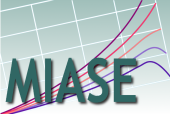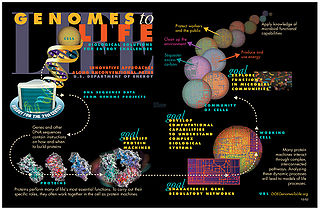
CellML is an XML based markup language for describing mathematical models. Although it could theoretically describe any mathematical model, it was originally created with the Physiome Project in mind, and hence used primarily to describe models relevant to the field of biology. This is reflected in its name CellML, although this is simply a name, not an abbreviation. CellML is growing in popularity as a portable description format for computational models, and groups throughout the world are using CellML for modelling or developing software tools based on CellML. CellML is similar to Systems Biology Markup Language SBML but provides greater scope for model modularity and reuse, and is not specific to descriptions of biochemistry.
Modelling biological systems is a significant task of systems biology and mathematical biology. Computational systems biology aims to develop and use efficient algorithms, data structures, visualization and communication tools with the goal of computer modelling of biological systems. It involves the use of computer simulations of biological systems, including cellular subsystems, to both analyze and visualize the complex connections of these cellular processes.
RuleML is a global initiative, led by a non-profit organization RuleML Inc., that is devoted to advancing research and industry standards design activities in the technical area of rules that are semantic and highly inter-operable. The standards design takes the form primarily of a markup language, also known as RuleML. The research activities include an annual research conference, the RuleML Symposium, also known as RuleML for short. Founded in fall 2000 by Harold Boley, Benjamin Grosof, and Said Tabet, RuleML was originally devoted purely to standards design, but then quickly branched out into the related activities of coordinating research and organizing an annual research conference starting in 2002. The M in RuleML is sometimes interpreted as standing for Markup and Modeling. The markup language was developed to express both forward (bottom-up) and backward (top-down) rules in XML for deduction, rewriting, and further inferential-transformational tasks. It is defined by the Rule Markup Initiative, an open network of individuals and groups from both industry and academia that was formed to develop a canonical Web language for rules using XML markup and transformations from and to other rule standards/systems.

BioModels is a free and open-source repository for storing, exchanging and retrieving quantitative models of biological interest created in 2006. All the models in the curated section of BioModels Database have been described in peer-reviewed scientific literature.

The Systems Biology Ontology (SBO) is a set of controlled, relational vocabularies of terms commonly used in Systems Biology, and in particular in computational modeling. SBO is part of the BioModels.net effort.

MIRIAM is a community-level effort to standardize the annotation and curation processes of quantitative models of biological systems. It consists of a set of guidelines suitable for use with any structured format, allowing different groups to collaborate and share resulting models. Adherence to these guidelines also facilitates the sharing of software and service infrastructures built upon modeling activities.
The Commission for the Management and Application of Geoscience Information (CGI), usually referred to by the unofficial "Commission for Geoscience Information" is subcommittee grade scientific organization that concerns itself with geological standard, information management and interoperability matters on a global scale.

The minimum information about a simulation experiment (MIASE) is a list of the common set of information a modeller needs to enable the execution and reproduction of a numerical simulation experiment, derived from a given set of quantitative models.
NeuroML is an XML based model description language that aims to provide a common data format for defining and exchanging models in computational neuroscience. The focus of NeuroML is on models which are based on the biophysical and anatomical properties of real neurons.

LibSBML is an open-source software library that provides an application programming interface (API) for the SBML format. The libSBML library can be embedded in a software application or used in a web servlet as part of the application or servlet's implementation of support for reading, writing, and manipulating SBML documents and data streams. The core of libSBML is written in ISO standard C++; the library provides API for many programming languages via interfaces generated with the help of SWIG.

JSBML is an open-source Java™ (API) for the SBML format. Its API strives to attain a strong similarity to the Java binding of the corresponding library libSBML, but is entirely implemented in Java and therefore platform independent. JSBML provides an elaborated abstract type hierarchy, whose data types implement or extend many interfaces and abstract classes from the standard Java library. In this way, JSBML integrates smoothly into existing Java projects, and provides methods to read, write, evaluate, and manipulate the content of SBML documents.
Identifiers.org is a project providing stable and perennial identifiers for data records used in the Life Sciences. The identifiers are provided in the form of Uniform Resource Identifiers (URIs). Identifiers.org is also a resolving system, that relies on collections listed in the MIRIAM Registry to provide direct access to different instances of the identified records.

Nicolas Le Novère is a British and French biologist. His research focus on modeling signaling pathways and developing tools to share mathematical models.











